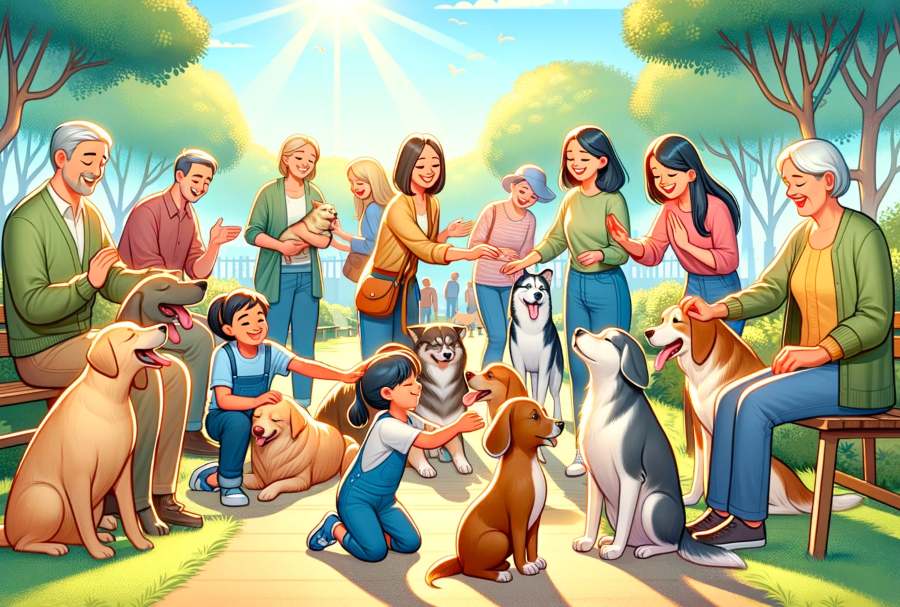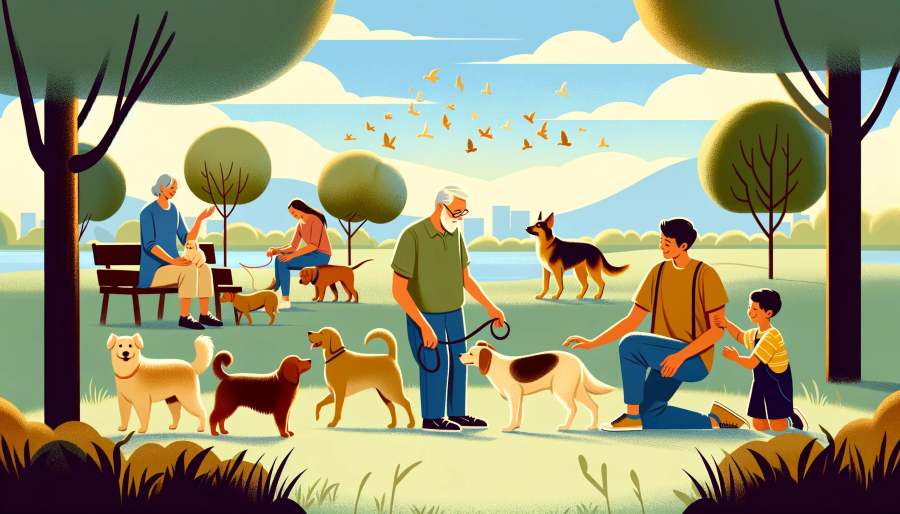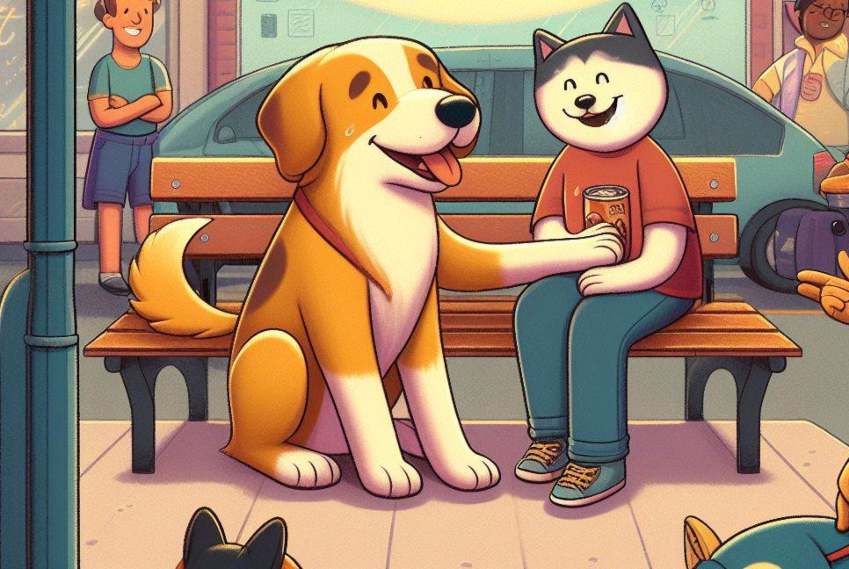Petting dogs can be one of life’s simple joys. The opportunity to make a new furry friend and feel their soft coat under your hand is a uniquely uplifting experience. However, not every dog is comfortable being petted by strangers. That’s why learning proper petting Manners is essential to ensure safe and positive interactions.
Getting Support and Reading Dog Body Language

Before reaching out to pet any dog, getting Support from the owner and looking for signs the dog is open to being tickled is essential. We’ll explore how to ask permission and read a dog’s body language politely.
Asking the Owner for Permission
- Don’t just assume it’s okay to approach and start rubbing.
- Make eye contact with the owner and politely ask, “May I pet your dog?”
- Wait for an explicit verbal confirmation before moving closer and interacting with the dog.
- If the owner seems hesitant or says no, graciously accept their decision and don’t take offence.
- Don’t assume you can pet a dog, even if they’re unleashed in a public area. Still, ask the owner first.
Reading a Dog’s Body Language
Before and while petting a dog, pay close attention to their body language for any signs of discomfort:
Signs a dog wants to be petted:
- Wagging tail
- Relaxed facial muscles
- Perked up ears
- Leaning into your hand
- Licking you
Signs a dog is uncomfortable:
- Growling or barking
- Ears flat back against the head
- Furrowed brow
- Tense body posture
- Yawning or lip-licking
- Turning or moving away
If a dog shows uncertain or stressed signals, do not attempt to pet them. Their safety chew and comfort should always come first.
Petting Manners – The Do’s and Don’ts

Once you have the owners, go ahead and see that the dog is receptive; follow these do’s and don’ts for safe, respectful petting:
Do’s
- Let them sniff your hand first. Hold your hand loosely in a fist to allow the dog to gather your scent. This helps them become more comfortable with you.
- Pet under the chin, on the chest, sides or back. These are generally the most enjoyed spots for canine pets.
- Stroke in the direction their fur naturally grows. This is smoothing rather than ruffling.
- Use calm, friendly voices and energy. Speak gently and move slowly.
- Keep petting sessions brief. Unless the owner indicates otherwise, a few gentle strokes or a minute or two of petting is usually sufficient.
Don’ts
- Don’t pet on the top of the head. Reaching over a dog can seem intimidating.
- Avoid hugging. Dogs view embracing as unnatural, and it can cause anxiety. Give them space.
- Refrain from making sudden movements. This can startle them. Move calmly and steadily.
- Avoid prolonged staring into their eyes. Direct eye contact can be perceived as threatening by some dogs.
- Only pet if the dog seems confident. Comfort and safety come first. Abort mission.
Petting Safety Tips for Kids
Kids and dogs can make great companions, and petting dogs teach children empathy. However, children need guidance to rub correctly. Use these tips when supervising kids petting dogs:
- Demonstrate asking the owner for permission first.
- Teach them to present the back of the hand, not an open palm
- Show safe petting zones like the chest, under the chin or back.
- Remind them to be very gentle with their petting.
- Do not allow hugging, poking, or grabbing.
- Monitor all interactions in case the dog becomes uncomfortable.
- Make sure kids do not disturb a sleeping or eating dog.
- Help them learn to read when a dog wants to be left alone.
With preparation and supervision, petting dogs can be a wonderfully enriching experience for kids.
Health Considerations for Petting Dogs

While the benefits of petting dogs are numerous, there are some health considerations to keep in mind as well:
Allergy Management
People with dog allergies should take precautions:
- Bring allergy medication with you in case of reactions
- Have hand sanitizer available to use after petting dogs
- Avoid letting dogs lick your face or hands
- Change and wash clothes after prolonged exposure to dogs
- Ask owners not to pet dogs that may trigger severe reactions
Importance of Hand Hygiene
To prevent the spread of germs:
- Always wash hands with soap and water after petting unknown dogs
- Teach children the importance of hand washing after petting
- Apply hand sanitizer when soap and water are unavailable.
- Avoid petting dogs if you have any open cuts or wounds on your hands
- Carry sanitizing wipes if regularly interacting with multiple dogs
With some simple precautions, people can safely enjoy petting dogs while minimizing the risks of allergies or illness.
The Role of Species in Petting
While every dog has a unique personality, some general breed traits can influence petting experiences.
Breeds That Enjoy Petting
- Labrador Retrievers – Extremely social and friendly, love pets from adoring fans.
- Goldendoodles – Bred to be docile and gentle, take well to being petted.
- Cavalier King Charles Spaniels – Sweet-tempered lapdogs that crave human touch.
- Maltese is a responsive companion dog that relishes affection and being stroked.
- Greyhounds – Quiet, gentle breeds that appreciate being petted.
Breeds That Are Wary of Petting
- Shiba Inus – Independent, aloof dogs that may be suspicious of strangers.
- Chow Chows – Stoic, serious breeds that don’t seek out affection.
- Basenjis is a Spirited, energetic dog that doesn’t typically enjoy prolonged petting.
- Afghan Hounds – Regal, elegant dogs that prefer admiration from afar.
- Border Collies – Active working dogs that would rather play than be petted.
However, individual temperament is just as crucial as breed tendencies. Never assume a dog’s personality is based only on their breed. Carefully observe each dog’s body language instead.
Petting Manners in Public Settings
When out in public areas, follow these rules to pet dogs politely and safely:
- Do not pet guide, service, police or military dogs; they are actively working and cannot be distracted.
- Be aware of your surroundings and give working dogs adequate space.
- Look for signs or guidelines about interacting with pets. Many stores or outdoor spaces have policies.
- Avoid disturbing other patrons. Don’t let petting interfere with other people using the space.
- Keep interactions brief so dogs don’t get overstimulated.
- Carry treats or toys to offer dogs if owners welcome petting.
- Be respectful if asked not to pet, even if other dogs are being petted nearby.
Remember, petting Manners protects you and the dogs you meet. Follow these public petting best practices for happy outings.
When You Should Not Pet a Dog

While most dogs love being petted, there are some situations where it is best not to pet a dog, even if the dog seems friendly and the owner gives permission:
- A dog that is sleeping or resting – Let sleeping dogs lie! Don’t disrupt their relaxation.
- A dog eating – Allow them to focus on their mealtime without distraction.
- A dog with puppies – Mother dogs protect their young and may perceive your hand as a threat.
- An injured or unwell dog – Don’t risk causing pain or stress to an already hurting dog.
- An anxious dog – If a dog seems fearful, unsure, or trembling, do not advance or attempt to pet.
- An unknown, unleashed dog – Stray or loose dogs can be unpredictable. Enjoy their cute faces from a distance.
Trust your instincts. If a situation does not feel proper or safe, walk away. The dog’s welfare should always come first.
Benefits of Petting Dogs for Humans and Canines
Science confirms that petting dogs benefits humans both physically and mentally. But the affection is reciprocated, with dogs enjoying the bonding time.
Benefits of Petting Dogs for Humans
- Reduced stress – Interacting with dogs decreases cortisol and increases oxytocin. Petting is calming.
- Lowered blood pressure – Time spent with dogs normalizes blood pressure in ways similar to medication.
- Increased happiness – Petting leads to the release of serotonin, dopamine and endorphins that lift moods.
- Social bonding – Touch and caretaking foster connections and emotional closeness.
Benefits of Petting for Dogs
- Enjoyable sensation – Dogs have more touch-sensitive nerve receptors than humans, so petting feels pleasurable.
- Eases anxiety – Gentle repetitive petting produces relaxing brainwave activity.
- Stimulation and comfort – Petting meets a dog’s needs for activity and affection.
- Trust building – Positive physical contact reinforces social bonding and security.
In the end, petting is meant to be a mutually enjoyable exchange. Follow proper manners , and it can be a rewarding experience all around!
Conclusion
When done safely and politely, petting dogs offers immense psychological and physiological benefits for both dogs and humans. By asking permission, respecting signs from the dog, using proper technique, and setting reasonable limits, you can ensure each dog petting session is fun and fulfilling for all.
Remember, not every dog enjoys constant petting from strangers. Setting canine comfort as the top priority means you’ll develop heartwarming connections with all the beautiful pups you meet. So go forth, make new furry friends, and reap the rewards of responsible dog petting!

